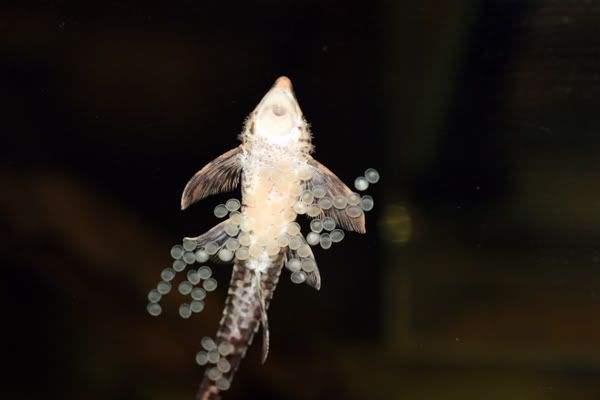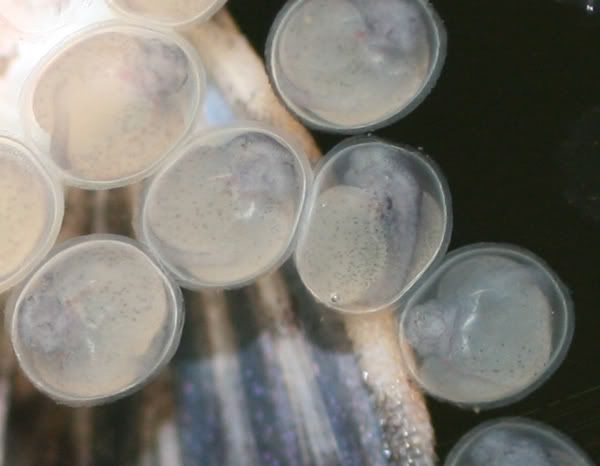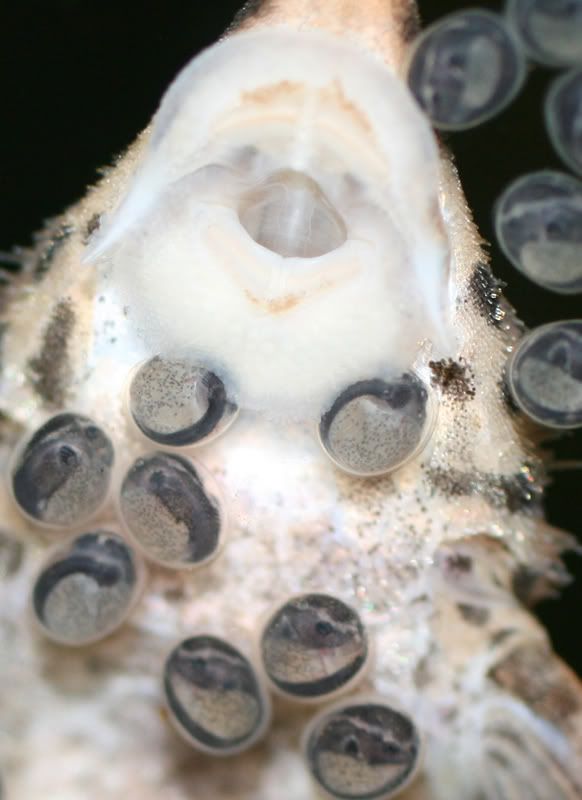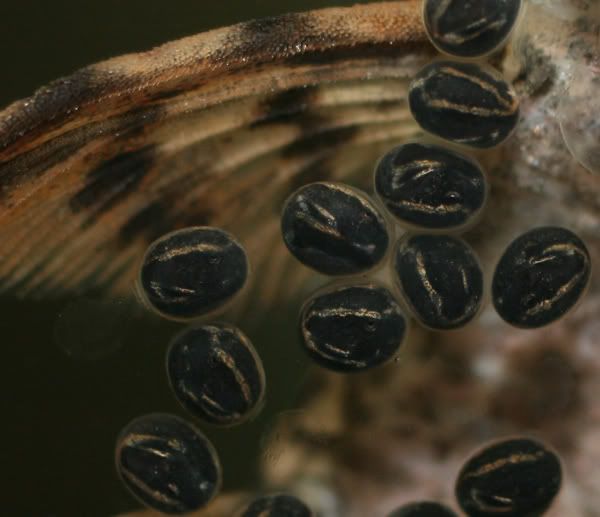Page 1 of 2
Sturisoma panamense egg hatching?
Posted: 10 Oct 2007, 00:14
by scat35
Hi,
I have just successfully bred my Sturisoma panamense for the first time and need some advice from people with experience in breeding these catfish.
I believe my eggs are on about day 6 from the way they look atm.
These guys have bred in a community tank which also houses 6 Corydoras sterbai, 13 semi-adult Peppermint bristlenose and 4 clown loaches.
I have heard 2 different peices of information which ive yet to have someone clarify for me.
1. The male must be kept with the eggs to assist in the hatching process.
2. Eggs can be removed successfully once they are darkened enough(developed enough) then successfully finished incubating and hatching in a fry saver.
Also what do people use as the first food for these fry as ive heard many different things.
Heres some pics ive taken so far.





Cheers

Craig
Posted: 10 Oct 2007, 06:05
by BlkMagik79
Wow!!! Simply amazing photos!!!
I don't know the answer to any of your questions, but can I ask what camera/lens combination you used to take the pictures?
Posted: 10 Oct 2007, 06:59
by scat35
Thanks

Im using a Canon EOS 400D with a 50mm f/2.5 compact macro.
Cheers
Craig
Posted: 10 Oct 2007, 07:14
by BlkMagik79
Wow...I have to admit that I can't get pictures like that even with my Dad's Nikon D80 with 105mm macro/micro w/vr...I just haven't learned enough yet...I'm very impressed.

Posted: 10 Oct 2007, 07:48
by Bas Pels
Approximately a month ago, I asked the same question. I was advised to leave the male with the eggs. However, this was not the base of my problem, it was the predation (convicts, Amatitlania nigrofasciatus (yes, they've been renamed again)), which have consumed the last litter as well.
However, the convivcts will be sold tomorrow

and the Sturiosoma will now have the change to produce offspring.
Than I will have your queries again: How does won get the fry growing
Posted: 10 Oct 2007, 09:03
by scat35
Im glad im not alone

Cheers

Craig
Sturisoma panamense egg hatching?
Posted: 10 Oct 2007, 19:54
by flash
Hi all
my sturisomas have layed eggs every 10 days or so for the last 2 years.i keep a trio of 1 female to 2 males in a 100 gall community tank .most of the time they lay the eggs on an internal filter which i remove on about day 6 .if they lay them on the glass i let them hatch then syphon the young out and put them in a 12 inch cube on their own.after a few weeks i transfer them to a 3 foot to grow on .
feeding is very hard and not many survive from each batch.keeping them in a small tank helps them to stay near to the food .i feed spirulina flake protine pellets and courgette for the first few weeks then introduce frozen bloodworm.
hope this helps flash
Posted: 10 Oct 2007, 20:12
by Bas Pels
It's certainly informative
Thanks
Posted: 11 Oct 2007, 01:51
by apistomaster
My Sturisoma spawn approximately every two weeks. I carefully slide them of the glass just prior to their hatching date. About 80% hatch after going through the siphon. I Siphon them into a net breeder in a bucket then hang it in the spawning tank. They all begin feeding within a few days. I use earth worm sticks for both my breeders and fry. The fry are left in the net breeder ~ two weeks then are transfered to a 20 gallon long. About 85% or more make it to one month; after that I notice no losses.
I think it is a mistake to assume these fish are primary herbivores. Mine just produced their largest spawn to date three days ago; 100 plus eggs. I provide them with a very strong current. Their native habitat, according to a friend who has collected them in Venezuela, is typically small fast moving streams in six to 12 inches of water. I try to simulate that environment.
I have not tried to remove their eggs any sooner because I do believe the male's care is much better than what I could provide as a substitute.
Good luck.
Posted: 11 Oct 2007, 09:49
by scat35
Thank you very much for all your help guys

Will keep you posted!
Cheers
Craig
Posted: 11 Oct 2007, 15:09
by scat35
Update

Have 2 hatched now and the rest are still cooking but look ready to go !!!

So do you guys reckon that a better ratio would be 2 males to one female to help reduce the pressure on just one male tending to eggs constantly?
Cheers

Craig
Posted: 11 Oct 2007, 15:54
by bronzefry
Beautiful photos. Thank you for posting them!
Amanda
Posted: 11 Oct 2007, 18:40
by apistomaster
Craig asked:
"So do you guys reckon that a better ratio would be 2 males to one female to help reduce the pressure on just one male tending to eggs constantly? "
Answer:
No, additional males make no difference because only the male that fertilized the eggs will guard them. The ~two week intervals is plenty of rest time, besides, the male will leave the eggs to feed during the incubation period. It is the female that commits the greater energy resources by producing the ova.
I have found that the number of eggs per spawn in a series of spawns diminishes over time. Eventually she will take a break of a month or so before resuming regular spawns. Then the number of eggs will again be greater, but again she will produce fewer eggs until she takes another rest break.
Posted: 11 Oct 2007, 19:26
by apistomaster
You will find it is much easier to gather these eggs up just before they hatch than trying to catch and handle the delicate fry.
I turn off all air or circulating pumps so I can work in still water.
Then I use a razor blade and siphon together so as I slide the blade underneath the eggs the siphon immediately transfers them to the net breeder.
It seems important to keep the fry in close proximity to a constant food supply and strong current. I place the return flow of the breeding tank's Eheim filter inside the net breeder. Many of the fry cling as close to the very edge of this strong current as they can. I also add a number of hollow ceramic filter bio media on the bottom of the net breeder. These provide structure and surfaces the fry use to cling to and graze on. The media soon becomes a surface that supports algae growth. This provides all the algae they seem to need because as I have already mentioned they mainly feed on the earth worm sticks( A pellet food) I use.
Sturisoma panamense egg hatching?
Posted: 11 Oct 2007, 20:03
by flash
Hi all
the only reason i have 2 males to one female is because thats what i bought. not to encourage them to spawn but the female will spawn with either male.at the moment both males are on eggs one on an internal fillter one on the glass and both lots layed on the same day.i can remove the ones on the internal a day before they hatch but have never tried to remove the eggs on glass.my female lays between 100 and 200 eggs each time and never seems to miss .
by the way larry what kind of survival rate do you get?i get a very low one about 20 out of 100.
cheers flash
Posted: 11 Oct 2007, 20:50
by apistomaster
Hi Flash,
I only have one female and three male Sturisoma breeders. She has spawned with various males but never with more than one per spawn and never more than ~100 eggs. These are six to seven inch specimens Total length not counting tail streamers.
All my losses seem to occur within the first weeks and I estimate the maximum loss rate at 15%. After one month there does not seem to be a problem with losses.
The fry usually double their length at two weeks post hatch. Then their growth rate is slow but steady.
I have experimented with various set ups with my first half dozen batches and found it was best to confine the fry at first rather than immediately place them in larger tanks and I have had my best results in shallow water tanks no deeper than 12 inches(30 cm. When I tried to raise some in a 55 gallon 20 inches tall I had nearly total losses by the end of two months.
I actually think the fry benefit from an even more extended period of time in the confinement of a net breeder as long as the tank is well filtered and otherwise not crowded.
I have two rearing tanks set up with two different batches of Sturisoma fry where they are sharing the 20 gal.long tanks with Corydoras hastatus and Corydoras habrosus breeders. The Corydoras are spawning and I am using the "natural" method where it is left as a permanent breeding set up and the Cory eggs and fry are left together. All survive together and if anything, the young Sturisoma and Corydoras of every size from newly hatched to breeders seem to exploit various microhabitats. It also makes these rearing tanks a bit more interesting to me.
I feel I am still very much in the learning stages of raising the Sturisoma but that the main area where I would like to see more improvement is growth rate but what I am seeing may prove to be normal. I think this because I am not losing fry any more and I have not found a better way of feeding them. I am expecting growth rates to change once the fry can easily consume live black worms and frozen blood worms. These are foods I use in conjunction with the earth worm sticks to condition my breeders.
Added info: I do offer live brine shrimp nauplii to the Sturisoma fry and they do eat them as they begin to die and stay on the bottom. The Corys of various sizes help eat these too. My largest Sturisoma fry are about 1-5/8 inches except for a couple older survivors which are ~2-inches.
Posted: 11 Oct 2007, 21:30
by Haavard Stoere
Beautiful photographs

Good luck raising the pups

Posted: 11 Oct 2007, 21:46
by apistomaster
Posted: 12 Oct 2007, 15:10
by scat35
Hi Guys

Day 8 now, 11 whiptails hatched and 40+ eggs still going!

Note my Corydoras sterbai decided to spawn all through the tank today also( eggs to the right of the frysaver

)
I have a perspex frysaver inside the tank where they spawned, this frysaver has a air driven uplifter which pulls water through the sponge which makes up one side of the frysaver, the sponge atm is covered with a finer meshed fry saver net to prevent the whiptails getting into/or through the sponge while they`re so small.

The frysaver is 8 inches deep and atm the fry are all hanging around the top of the fry saver, so will they move around more and actively start to feed? Or are they still consuming their eggsac atm still? ( i cant see a eggsac but you guys will know better

)
Have also made up a food from a article to try and feed these guys with.
Its 3 parts Spirulina powder and 1 part Agar powder mixed with boiling water to make a paste, then flat packed into freezer bags so when set , it can be cut into blocks and fed to the fry ( thats the theory anyway

)
So will keep going with this and thanks very much for some top info from you guys

Cheers
Craig
Posted: 12 Oct 2007, 15:39
by Norman
Hi Larry,
apistomaster wrote:I have never been able to be certain which one I have. I know they were from Colombian exporters and believe them to likely be Sturisoma aureum.
I thought we clarified it in a separate thread by you some month ago... ? You can be sure keeping
S.aureum.
apistomaster wrote:I wonder about the Sturisoma panemense identification because their are so few Panamanian fish imported, at least into the USA.
I do not belive that this imaged
Sturisoma is
S.panamense. The body of this species has a different shape, the fins have larger messurements.
Some habitus-photos will give the solution.
best regards
Norman
Posted: 12 Oct 2007, 19:46
by apistomaster
Norman wrote:Hi Larry,
apistomaster wrote:I have never been able to be certain which one I have. I know they were from Colombian exporters and believe them to likely be Sturisoma aureum.
I thought we clarified it in a separate thread by you some month ago... ? You can be sure keeping
S.aureum.
apistomaster wrote:I wonder about the Sturisoma panemense identification because their are so few Panamanian fish imported, at least into the USA.
I do not belive that this imaged
Sturisoma is
S.panamense. The body of this species has a different shape, the fins have larger messurements.
Some habitus-photos will give the solution.
best regards
Norman
Hi Norman,
I am as sure I can be that I am working with S. aureum but that is never 100%. We know too little for me to be absolutely certain but it is near enough for practical purposes.
Hi Craig,
You will have other spawns to experiment with but I think your algae based gel will prove to be nutritionally inadequate as the staple food but will be a good supplement. There has been every indication to me in the nearly two years working with my Sturisoma that vegetables come after meat in dietary importance. The fry "burn fuel" fast and given a choice my fry and adults have always gone after the meat based high protein foods first. The algae seems to be of secondary importance.
The fry usually begin to feed within 48 hours after going through a full term incubation. More if you remove then just prior to hatching.
Posted: 14 Oct 2007, 01:37
by scat35
Hi Guys

Am still waiting for these fry to start to feed?
Most of the fry have only hatched 24 hours ago but some are up to 72 hours now?
Its a nervous wait

Cheers
Craig
Posted: 16 Oct 2007, 10:31
by Norman
Hi Larry,
apistomaster wrote:
Hi Norman,
I am as sure I can be that I am working with S. aureum but that is never 100%. We know too little for me to be absolutely certain but it is near enough for practical purposes.
Can you tell me your concrete doubts?
best regards
Norman
Posted: 24 Oct 2007, 14:36
by scat35
Hi Guys

My fry are now 10 days old and have had mixed results.
For the first 7 days i only lost 8 fry, then over the next 3 days ive lost around 25.
My biggest loss was when i tried to change them from the spirulina/agar paste to a day of zuccini and hakari carnivore pellets.
They just dont seem interested in feeding much and have 10 left now.
Ive another big batch ready to hatch over the next few days and will try again ( Larry i havent found anything like the earthworm sticks you use yet unfortuately )
Cheers

Craig
Posted: 24 Oct 2007, 17:31
by Shane
Can you tell me your concrete doubts?
Norman,
I do not want to speak for Larry, but there is much confusion surrounding the identification of northern Colombian
Sturisoma spp. Only one sp,
S. aureum, has been formally described, yet what appear to be two distinct spp of
Sturisoma are exported from the Magdalena system. There is an additional "sp" (not
Sturisomatichthys leightoni) that I have not been able to decide if it is a
Sturisomatichthys or
Sturisoma, and of the three, it actually most closely matches the description of
S. aureum.
All the below pictures were taken by me in Colombia between 2002-2004 when I lived there.
This is a shipment at a Bogota exporter of what Evers and Seidel called
S. "Colombia" in the first edition of their book. It was mentioned to me that in the 2nd Ed. this fish is called
S. aureum. It is collected in the lower Magdalena. For many years hobbyists called it
S. panamense. Note the overall coloration and straight dorsal.


This is the second sp that is collected from the lower Magdalena. Note the sickle-like dorsal and coloration.

This is the "mystery" sp that appears to most closely match the description of
S. aureum. Miles (1947) described
S. aureum as "Es intermedio entre panamense y leightoni." This suggests some doubt on Miles' part as to whether the fish was a
Sturisoma or
Sturisomatichthys.

-Shane
Posted: 24 Oct 2007, 17:39
by apistomaster
Hi Shane,
You summed up well the reasons for my lingering doubts about the identity of my species.
As I have said, I believe I do have S.aureum but several similar species are exported from Colombia hence my uncertainty.
Posted: 24 Oct 2007, 18:06
by Norman
Hi Shane,
Thank you for this summary.
It is right that Evers and Seidel called one species S.sp. "Columbia" in the first edition of the first catfish atlas. But in the second edition they call them S.aureum.
When I look to the pictures you had postet I see in image 2 and 3 two specimen with an similar coloration. Particular the marking 'golden' headsides are present on both specimen. This is identical with the description of S.aureum. What differences in coloration do you mean?
In my opinion/experiance the shape of the dorsal fin depends on the age of the specimen. Young sexual maturity S.aureum have a nearly streight dorsal fin, when they are getting older the dorsal fin bent.
The "mystery" one seems to be very young, not sexual mature. Do you have some pictures of the mature?
best regards
Norman
Posted: 24 Oct 2007, 18:33
by racoll
Quick link to the other current discussion on
is
HERE.
Could the third picture be of
S. festivum?
It has the dorsal saddle colouration, and Evers & Seidel report that it "enjoys a relatively broad distribution in Colombia and is regularly imported for the aquarium hobby".
I have not been able to decide if it is a Sturisomatichthys or Sturisoma
Not surprised....
Covain & Fisch-Muller (2007) write:
"Sturisomatichthys is distinguished from Sturisoma primarily by the absence of a rostrum.........The weakness of this diagnostic feature could lead to the synonymy of Sturisomatichthys with Sturisoma."
Posted: 25 Oct 2007, 18:01
by Shane
In my opinion/experiance the shape of the dorsal fin depends on the age of the specimen.
I had this same theory until I was able to see literally 1,000s of these fish right out of the wild. I realize that the top picture is small, but I posted it to show a large shipment of various sizes all with the same straight dorsal. As you can see, the male in the second pic (note the heavy cheek growth) is a large, sexually mature adult fish. It has a straight dorsal spine.
I'll try to find some better pics that illustrate the pattern differences.
The "mystery" one seems to be very young, not sexual mature. Do you have some pictures of the mature?
I'll look for some more pics, but they do not get much bigger. They are very gracile and the body size, even of an adult, is not much more robust than that of a
Farlowella.
-Shane
Posted: 25 Oct 2007, 18:07
by Shane
I had forgotten this fish but found the pic in my collection. It was captured in the northern Magdalena.

I think we can safely say that it is not the same as any of the above spp.
-Shane
























